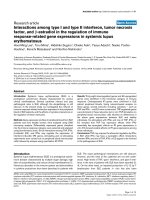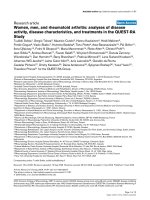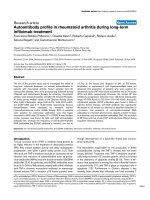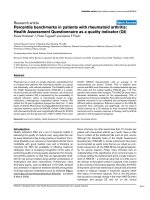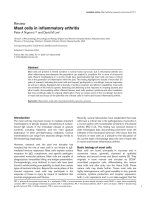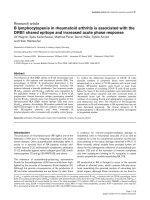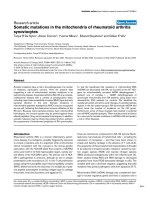Báo cáo y học: "Sinus aspergilloma in rheumatoid arthritis before or during tumor necrosis factor-alpha antagonist therapy" ppsx
Bạn đang xem bản rút gọn của tài liệu. Xem và tải ngay bản đầy đủ của tài liệu tại đây (752.36 KB, 9 trang )
Open Access
Available online />Page 1 of 9
(page number not for citation purposes)
Vol 11 No 6
Research article
Sinus aspergilloma in rheumatoid arthritis before or during tumor
necrosis factor-alpha antagonist therapy
Ariane Leboime
1
, Jean-Marie Berthelot
2
, Yannick Allanore
3
, Lama Khalil-Kallouche
1
,
Philippe Herman
4
, Philippe Orcel
1
and Frédéric Lioté
1
1
Fédération de Rhumatologie, Pôle Appareil Locomoteur (centre Viggo Petersen), Hôpital Lariboisière, Paris Diderot University, 2 rue Ambroise Paré,
Paris 75010, France
2
Service de Rhumatologie, Pôle Appareil Locomoteur, CHRU de Nantes, 1 place Alexis Ricordeau, Nantes 44000, France
3
Service de Rhumatologie, Pôle Appareil Locomoteur, Hôpital Cochin, Paris Descartes University, 27 rue du Faubourg saint Jacques, Paris 75014,
France
4
Service d'ORL, Pôle Tête Et Cou, Hôpital Lariboisière, Paris Diderot University, 2 rue Ambroise Paré, Paris 75010, France
Corresponding author: Frédéric Lioté,
Received: 6 Aug 2009 Revisions requested: 9 Sep 2009 Revisions received: 15 Oct 2009 Accepted: 3 Nov 2009 Published: 3 Nov 2009
Arthritis Research & Therapy 2009, 11:R164 (doi:10.1186/ar2849)
This article is online at: />© 2009 Leboime et al.; licensee BioMed Central Ltd.
This is an open access article distributed under the terms of the Creative Commons Attribution License ( />),
which permits unrestricted use, distribution, and reproduction in any medium, provided the original work is properly cited.
Abstract
Introduction In 2008, the Food and Drugs Administration
required manufacturers of TNFα antagonists to strengthen their
warnings about the risk of serious fungal infections in patients
with rheumatoid arthritis (RA). Sinus aspergilloma occurs
occasionally in RA patients and can progress to invasive
Aspergillus disease. The purpose of this study was to describe
symptomatic sinus aspergilloma in RA patients treated with
TNFα antagonists.
Methods Retrospective descriptive study of symptomatic cases
of sinus aspergilloma in patients with RA followed in three
French university hospitals. A systematic literature review was
performed.
Results Among 550 RA patients treated with TNFα
antagonists, six (1.1%) had symptomatic maxillary aspergilloma
diagnosed by computed tomography before or during TNFα
antagonist therapy. None had chronic neutropenia.
Aspergilloma treatment was with surgery only in all six patients.
In the literature, we found 20 reports of Aspergillus infection in
patients with chronic inflammatory joint diseases (including 10
with RA). Only 5/20 patients were treated with TNFα
antagonists (invasive lung aspergillosis, n = 3; intracranial
aspergillosis, n = 1; and sphenoidal sinusitis, n = 1).
Conclusions Otorhinolaryngological symptoms must be
evaluated before starting or switching TNFα antagonists.
Routine computed tomography of the sinuses before starting or
switching TNFα antagonists may deserve consideration.
Introduction
The risk of infection is increased in patients with rheumatoid
arthritis (RA). Before the introduction of TNFα antagonists, a
retrospective study showed a twofold increase in the risk of
serious infections among RA patients compared with non-RA
patients [1]. Factors that increase the risk of infections in RA
include disease-related immune dysfunction (involving T cells
such as T-helper type 1 cells and, as described more recently,
T-helper type 17 cells) [2] and immunosuppressive effects of
drugs used to treat the disease, such as long-term glucocorti-
coids, disease-modifying antirheumatic drugs (DMARDs), and
TNFα antagonists [3,4]. Other factors may be involved, includ-
ing immobility, skin breaks, joint surgery, leukopenia, diabetes
mellitus, and chronic lung disease.
The infections encountered in RA patients affect a variety of
sites (upper and lower respiratory tracts, lungs, joints, bone,
skin, soft tissues, and so forth) [5] and can be caused by bac-
teria, viruses, fungi, or mycobacteria. RA patients may experi-
ence reactivation of latent infection such as tuberculosis,
which is the most commonly reported granulomatous infection
in patients treated with TNFα antagonists [6]. Preventive strat-
egies have been developed to identify patients at risk for latent
tuberculosis [7-9]. Other infections occurring during TNFα
antagonist therapy include legionellosis, listeriosis, pneumo-
CT: computed tomography; DMARD: disease-modifying antirheumatic drug; RA: rheumatoid arthritis; TNF: tumor necrosis factor.
Arthritis Research & Therapy Vol 11 No 6 Leboime et al.
Page 2 of 9
(page number not for citation purposes)
cystosis, histoplasmosis, and aspergillosis [6,10]. A recent
warning issued by the Food and Drugs Administration and
supported by the American College of Rheumatology Drug
Safety Committee draws attention to histoplasmosis and other
invasive fungal infections, including fatal cases, reported in RA
patients taking TNFα antagonists (FDA Alert 9/4/2008).
Among fungal infections, aspergillosis is usually due to
Aspergillus fumigatus and produces a broad spectrum of
presentations, ranging from benign allergic disease to invasive
infection. Before starting TNFα antagonist therapy, a number
of investigations are performed routinely to rule out contraindi-
cations such as infections. These investigations include a
chest radiograph and a tuberculin skin test for evidence of
tuberculosis, as well as other tests indicated by the clinical
symptoms. Nasal and/or sinus symptoms (such as nasal
obstruction, chronic rhinitis, postnasal drip, recurrent
epistaxis, foul smell, facial pain or headache) should therefore
be evaluated by computed tomography (CT) to look for sinus
disorders, including sinus aspergilloma, despite the absence
of epidemiological evidence that RA predisposes to patient-
reported sinus disorders (allergic, viral or bacterial) [11].
Aspergilloma, also called fungus ball, is a clump of fungus
growing in a cavity, in the lung or a sinus, often a maxillary
sinus. Aspergilloma has been found in 3.7% of patients under-
going surgery for chronic inflammatory sinusitis [12].
Sinus aspergilloma is often asymptomatic and may therefore
be overlooked during the workup performed before starting
TNFα antagonist therapy. Furthermore, TNFα antagonists may
exacerbate latent fungal infections, causing a focal aspergil-
loma to progress to invasive aspergillosis. Our objective was
to investigate cases of sinus aspergilloma seen in RA patients
before or during TNFα antagonist therapy. To this end, we
conducted a retrospective study in three university hospitals
and reviewed the relevant literature. The results suggest that
routine CT of the sinuses may deserve consideration before
starting TNFα antagonist therapy.
Materials and methods
Retrospective patient review
A retrospective descriptive study was carried out in three uni-
versity hospitals. In France, TNFα antagonist therapy can be
started only in hospital departments of internal medicine and
rheumatology. Between 1999 and 2007, patients were identi-
fied using the database of each hospital and the keywords:
(rheumatoid arthritis or spondylarthropathy) AND (aspergil-
loma or fungus ball).
Standardized forms were used to collect the following data:
sex, age, disease duration, co-morbidities, symptomatic and
immunosuppressive treatments received before the diagnosis
of aspergilloma (including joint surgery), and otorhinolaryngo-
logical history. The clinical presentation and treatment of the
aspergilloma were recorded. Since this was not a prospective
study, no ethical approval has been considered. In addition,
patient anonymity was preserved in all parts of the retrospec-
tive review and result presentation.
Systematic literature review
We searched the PubMed database up to October 2008 and
the abstracts of the EULAR and American College of Rheuma-
tology scientific meetings held in 2005, 2006, 2007, and
2008. Two searches were carried out in the PubMed data-
base, using the following keywords: (rheumatoid arthritis OR
ankylosing spondylitis OR spondylarthritis) AND (aspergilloma
OR fungus ball OR aspergillosis OR sinusitis). Case reports,
case series, and reviews were selected and analyzed using a
standard form.
Results
Patient identification
We identified six patients with sinus aspergilloma among 550
(6/550, 1.1%) patients with RA undergoing screening for, or
receiving, TNFα antagonist therapy. Their distribution by study
center was as follows: three out of 50 patients at the Lari-
boisière Hospital, Paris; two out of 200 patients at the Nantes
Hospital, Nantes; and one out of 300 patients at the Cochin
Hospital, Paris.
Patient characteristics
The main patient characteristics are presented in Table 1. All
six patients with aspergilloma were women meeting American
College of Rheumatology criteria for RA [13]. The mean age
(± standard deviation) was 58 ± 8 years and the mean RA
duration was 20.0 ± 10.2 years. All six patients had severe
joint destruction. Co-morbidities included hypertension in
three patients and iron-deficiency anemia in two patients.
Bronchiectasis was a feature in one patient. Two patients had
a history of appropriately treated pulmonary tuberculosis, with
no reactivation during TNFα antagonist therapy. None of the
patients had diabetes mellitus.
Treatments for RA are also presented in Table 1. All patients
had a history of inadequate disease control with glucocorti-
coids and methotrexate. Other DMARDs, including lefluno-
mide, were used in two patients, one of whom was still on
leflunomide at the time of aspergilloma diagnosis.
At the time of aspergilloma diagnosis, four patients were tak-
ing TNFα antagonist therapy (infliximab, n = 3; and etanercept,
n = 1). Of these four patients, two were on methotrexate and
one was on leflunomide; all four patients were on low-dose
glucocorticoid therapy. None of the six patients had chronic
neutropenia at the time of aspergilloma diagnosis. Four
patients had a history of surgery on one or more joints.
Description and treatment of the aspergillomas
The main data are presented in Tables 2 and 3. A history of
sinusitis was noted in four patients, including one patient who
Available online />Page 3 of 9
(page number not for citation purposes)
Table 1
Characteristics of the six patients with rheumatoid arthritis and sinus aspergilloma
Case RA duration
a
(years) Age at aspergilloma
onset (years)
Co-morbidities Previous RA
treatment other than
TNFα antagonists
TNFα antagonist,
date
Surgery for RA
117 53 Hepatitis,
hypertension,
hypothyroidism,
gastric ulcer,
bronchiectasis
Glucocorticoid
therapy, methotrexate,
leflunomide
Infliximab, March
2003
No
2 32 66 Hypertension,
tuberculosis,
osteoporosis, uveitis,
coronary artery
disease
Glucocorticoid
therapy, methotrexate
Infliximab, November
2001
Yes
3 15 47 Primary tuberculosis,
iron-deficiency
anemia
Glucocorticoid
therapy, methotrexate,
leflunomide,
salazopyrine
Etanercept, February
2003
Yes
4 39 70 Hypertension Glucocorticoid
therapy, methotrexate
Infliximab, March
2002; etanercept,
July 2003
No
5 15 53 Glucocorticoid
therapy, methotrexate,
salazopyrine,
hydroxychloroquine
Yes
6 12 52 Chronic hepatitis B,
iron-deficiency
anemia, osteopenia
Glucocorticoid
therapy, methotrexate,
salazopyrine
Yes
a
Rheumatoid arthritis (RA) duration at aspergilloma diagnosis.
Table 2
Previous otorhinolaryngological disease and aspergilloma characteristics
Case Previous/active ENT disease Maxillary sinus involved Aspergilloma diagnosis Rheumatoid arthritis treatment at
aspergilloma diagnosis
1 Maxillary sinusitis treated surgically/
active ENT symptoms
Right December 2004 Infliximab, glucocorticoid therapy (8 mg/
day), leflunomide (20 mg/day)
2 None/active ENT symptoms Right April 2007 Etanercept (25 mg/week), glucocorticoid
therapy
(6 mg/day), methotrexate (15 mg/day)
3 Chronic sinusitis/active ENT
symptoms
Left July 2005 Etanercept, glucocorticoid therapy
4 Chronic sinusitis/active ENT
symptoms
Left June 2007 Etanercept (50 mg/week), methotrexate
(15 mg/day), glucocorticoid therapy (6
mg/day)
5 None/active ENT symptoms Right January 2005 Glucocorticoid therapy (7 mg/day),
salazopyrine
(1.5 g/day), methotrexate (15 mg/week)
6 Chronic sinusitis/active ENT
symptoms
Right March 2006 salazopyrine (2 g/day)
ENT, ear nose throat.
Arthritis Research & Therapy Vol 11 No 6 Leboime et al.
Page 4 of 9
(page number not for citation purposes)
had had surgery for maxillary sinusitis. All six patients had uni-
lateral aspergilloma located in a maxillary sinus. At diagnosis,
all patients had symptoms such as nasal obstruction, recurrent
sinusitis with facial pain, or hemorrhagic rhinorrhea. Serology
for aspergillosis was negative in the three tested patients. For
four patients, CT scans of the sinuses obtained before surgery
were available as films or electronic files and were reviewed for
bone involvement by an experienced otorhinolaryngology sur-
geon (PH). The aspergilloma was visible as a soft tissue mass
(Figure 1). Hyperdense opacities were seen in three patients.
In two patients the sinus wall was thickened, suggesting
chronic inflammation.
The aspergilloma was removed surgically in all six patients. No
systemic antifungal agents were given. Local aspergilloma
recurrence developed in two patients and required one addi-
tional and two additional surgical procedures, respectively.
The patient who had three surgical procedures in all experi-
enced acute bleeding after the third operation, and required
transfusion of a red cell pack and reoperation for hemostasis.
Impact on TNFα antagonist therapy
As shown in Table 3, four patients discontinued TNFα antag-
onist therapy until surgery was performed. In one patient
(Patient 6), TNFα antagonist therapy initiation was delayed
because of the diagnosis of aspergilloma. One patient was
therefore screened for but never received TNF antagonists.
Review of the literature
We identified 23 cases of aspergillosis in patients with chronic
inflammatory diseases. The underlying disease was RA in 12
patients (Patients 30 to 41) (Table 4), ankylosing spondylitis in
nine patients (Patient 18 and Patients 42 to 49), chronic pol-
yarthritis in one patient (Patient 50), and Crohn's disease in
one patient (Patient 19) (Table 5).
Of the 12 RA patients, four were receiving TNFα antagonist
therapy (infliximab, n = 3; etanercept, n = 1) at diagnosis of
aspergillosis. All three cases of lung aspergilloma in RA
patients occurred during DMARD therapy without TNFα
antagonist therapy. Of the three patients with invasive lung
aspergillosis, one patient was on TNFα antagonist therapy.
The four RA patients on TNFα antagonist therapy had severe
Aspergillus disease; there were two cases of pulmonary
aspergillosis, one case of invasive pulmonary aspergillosis,
and one case of intracranial aspergillosis.
Table 3
Treatment of sinus aspergilloma and impact on TNFα antagonist therapy
Case Systemic antifungal treatment Surgical treatment Impact on TNFα antagonist therapy
1 Aspergilloma removal after meatotomy in January
2005
Temporary discontinuation
2 May 2007 Treatment stopped before surgery
3 August 2005, September 2006 Temporary discontinuation
4 Aspergilloma removal by endoscopy in June 2007 Treatment stopped before surgery
5 Aspergilloma removal after meatotomy in January
2005
TNFα antagonist therapy considered
contraindicated because of the aspergilloma
6 Aspergilloma removal after meatotomy in August
2006, December 2006, September 2007
TNFα antagonist therapy delayed for 18 months
Figure 1
Aspergilloma visible as a soft tissue massAspergilloma visible as a soft tissue mass. Computed tomography
(coronal view) of the maxillary sinus in Patient 6 before the first surgical
procedure. Note the mass containing hyperdense foci that are highly
suggestive of aspergilloma (arrow).
Available online />Page 5 of 9
(page number not for citation purposes)
Table 4
Aspergillus disease in rheumatoid arthritis patients: literature review
Type of Aspergillus disease Site TNFα antagonist Other treatment Outcome Reference
Aspergilloma Lung No Hydroxychloroquine Death [31]
Invasive aspergillosis Lung No Methotrexate Recovery [32]
Aspergilloma Lung No Glucocorticoid therapy Recovery [33]
Aspergilloma Lung No Glucocorticoid therapy, salazopyrine,
methotrexate
Recovery [34]
Invasive aspergillosis Lung Infliximab Glucocorticoid therapy, leflunomide Recovery [35]
Rheumatoid nodule colonization Lung No Glucocorticoid therapy, methotrexate Death [36]
Aspergillosis Lung Infliximab Methotrexate ? [37]
Aspergillosis Lung Etanercept Not available ? [38]
Invasive aspergillosis Lung No Not available Not available [39]
Aspergillosis Lung No Glucocorticoid therapy, methotrexate,
leflunomide
Death [40]
Aspergillosis Lung No Methotrexate Recovery [41]
Aspergilloma Sphenoidal sinus Infliximab Glucocorticoid therapy Recovery [42]
Table 5
Aspergillus disease in patients with other chronic inflammatory joint diseases: literature review
Type of Aspergillus
disease
Site Joint disease Other treatment
a
TNFα antagonist Outcome Reference
Aspergilloma Lung Ankylosing
spondylitis
? ? [43]
Aspergilloma Lung Ankylosing
spondylitis
Radiation therapy Recovery [44]
Aspergilloma Lung Ankylosing
spondylitis
? Recovery [45]
Aspergilloma Lung Ankylosing
spondylitis
? ? [46]
Aspergilloma (× 2) Lung Ankylosing
spondylitis
Radiation therapy Recovery,
recurrence
[47]
Aspergilloma +
invasive aspergillosis
Lung Ankylosing
spondylitis
? Improvement [17]
Aspergilloma Lung Ankylosing
spondylitis
? ? Recovery [48]
Aspergilloma Lung Ankylosing
spondylitis
? Recovery [49]
Aspergillosis Frontal sinus,
meningitis,
encephalitis
Chronic polyarthritis GC Recovery [50]
Invasive aspergillosis Lung Crohn's disease Infliximab Death [20]
Aspergillosis Intra-cranial Ankylosing
spondylitis
GC Etanercept Recovery [19]
a
Including glucocorticoid therapy (GC) and disease-modifying antirheumatic drugs.
Arthritis Research & Therapy Vol 11 No 6 Leboime et al.
Page 6 of 9
(page number not for citation purposes)
Of the nine patients with ankylosing spondylitis, one was on
TNFα antagonist therapy and had a right orbital apex localiza-
tion of aspergillosis. Eight patients had lung aspergilloma, and
among them one progressed into an invasive lung aspergillo-
sis. Interestingly, one patient with unclassified chronic polyar-
thritis had frontal sinus involvement and meningoencephalitis.
None of the case reports mentioned neutropenia at the time of
diagnosis. All but two RA patients were taking glucocorticoids
alone or with methotrexate (n = 4) or with leflunomide (n = 2,
with methotrexate in one case). Little information was available
about the treatments in the ankylosing spondylitis patients;
however, two of these patients received radiation therapy to
the spine. Of the 19 patients for whom outcome information
was available, four (21%) patients died. Furthermore, one of
the patients who recovered experienced a recurrence.
Discussion
We describe the cases of six RA patients with symptomatic
sinus aspergilloma diagnosed during screening for, or treat-
ment with, TNFα antagonists. All six patients were treated sur-
gically. This small series represents almost 1.1% of 550 RA
patients treated with TNFα antagonists between 1999 and
2007 at three university hospitals in France.
The relatively high rate of sinus aspergilloma in our study was
somewhat unexpected. A literature review, however, identified
64 cases of invasive aspergillosis in patients taking TNFα
antagonists [10]. There were also 84 cases of invasive histo-
plasmosis and 64 cases of invasive candidiasis. The predomi-
nant clinical presentation of Aspergillus disease in this study
of invasive fungal infections was invasive pulmonary aspergil-
losis. No cases of sinus involvement were noted, but no infor-
mation was available about whether routine sinus imaging was
performed [10]. In our study, CT of the sinuses was performed
only to investigate symptoms. Sinus aspergilloma may remain
asymptomatic for several years, however, and may therefore
be underestimated.
Sinus involvement with Aspergillus may be either invasive or
noninvasive. Invasive sinus aspergillosis may be indolent or ful-
minant. Noninvasive Aspergillus sinusitis may manifest as aller-
gic fungal sinusitis or mycetoma (aspergilloma). Mucosal
invasion by fungal hyphae and presence of a granulomatous
response indicate invasive disease. However, the two forms
may be difficult to differentiate; thus, allergic fungal sinusitis
may spread intracranially and, on the other hand, indolent inva-
sive aspergillosis may be well tolerated. Evaluating the risk of
progression to invasive disease is crucial in patients with sinus
aspergilloma. Noninvasive Aspergillus sinusitis, which usually
remains confined to one sinus, occurs in immunocompetent
patients; whereas invasive sinus aspergillosis chiefly affects
immunocompromised patients, such as bone marrow trans-
plant recipients or patients with prolonged neutropenia
caused by chemotherapy [14] or hematologic malignancies.
Several cases of aspergilloma who progressed into an inva-
sive form have been described. First, a fatal case of aspergil-
loma with progression to invasive disease after kidney
transplantation and immunosuppressive treatment has been
reported [15]. In a patient with diabetes mellitus and cirrhosis
of the liver, a maxillary aspergilloma spread into the orbit and
up to the cribriform plate, leading to the patient's death [16].
Elliott and colleagues described a patient with ankylosing
spondylitis who had fever and cough. Diagnosis of concomi-
tant aspergilloma and invasive aspergillosis of the lung was
made by sputum analysis and histology of transbronchial lung
biopsy. The patient improved with intraconazole treatment
[17]. Finally, a patient with frontal sinus aspergilloma pre-
sented with right-sided pyocele expanding into the orbit; she
had no detectable immunodeficiency [18]. Two of these cases
[16,18] were unusually aggressive forms of noninvasive
aspergilloma exhibiting tumor-like behavior with local spread
and bone erosion but no histological invasion.
The extent to which drugs used to treat chronic inflammatory
joint disease may promote progression of sinus aspergilloma
to invasive aspergillosis deserves discussion. Little is known
about the outcome of aspergilloma in patients taking TNFα
antagonists. Our literature review identified a single previous
case of sinus aspergilloma during TNFα antagonist therapy, in
a patient with involvement of the sphenoidal sinus (Patient 38).
Neither the mucosa nor the sinus wall was invaded in this
patient. Of our six patients, four were on TNFα antagonist ther-
apy at the time of aspergilloma diagnosis. None had bone ero-
sions or spread to other sinuses. Our data suggest that the
prognosis of maxillary sinus aspergilloma in RA patients on
TNFα antagonist therapy may be similar to that in patients
without RA or immunosuppressive treatment. Recurrences
requiring repeat surgery occurred in two out of our six patients.
Recurrences may complicate incomplete removal of aspergil-
loma during minimally invasive surgery, which is useful in these
fragile patients but provides limited exposure.
We identified several previous reports of pulmonary aspergil-
loma and invasive aspergillosis in patients with chronic inflam-
matory joint diseases (Table 4). Another patient had central
nervous system aspergillosis [19]. Most of these patients had
RA or ankylosing spondylitis, although one patient had
Crohn's disease [20]. All were taking immunosuppressive
drugs such as glucocorticoids and methotrexate, and six
patients were taking TNFα antagonists. No patient experi-
enced progression from noninvasive to invasive Aspergillus
disease after starting TNFα antagonist therapy. Anecdotal
including invasive sphenoidal sinus aspergilloma and fatal
cases have been reported in patients with vasculitis, such as
Wegener's disease and temporal arteritis, but there are not
included in the present review since anti-TNF agents are not
indicated in these conditions.
Available online />Page 7 of 9
(page number not for citation purposes)
Fungal cultures were positive in 80 to 97% of patients with
chronic rhinosinusitis, and mycetoma was found in 13 to
28.5% of patients with chronic maxillary sinusitis [21,22].
Aspergillus spp. are the main pathogen found in chronic
sinusitis (75%). Candida albicans, Penicillium spp., and
Streptomyces spp. also occur [21]. Aspergillus spp. is a
saprophytic ubiquitous fungus found in organic debris, dust,
food, spices, and rotting plants. Of the nearly 200 species,
only a few are pathogenic, predominantly A. fumigatus,
Aspergillus flavus, and Aspergillus niger. Aspergillus is a fila-
mentous fungus that has septate hyphae and reproduces as
asexual conidia [16]. A higher incidence of Aspergillus dis-
ease has been reported in areas that have a hot dry climate -
especially of A. flavus, often described in Sudan [23]. The fun-
gus is usually acquired from an inanimate reservoir, by inhala-
tion of airborne spores. Moreover, hospital construction work
has been described as a risk factor for fungal infection [24].
Environmental measures such as impermeable barriers at con-
struction sites, wearing face masks, and closing doors and
windows should therefore be recommended in hospitals,
especially in oncology or hematology units. Similar prophylac-
tic measures may deserve consideration in hospitals manag-
ing patients on TNFα antagonist therapy; they have been
adopted at our institution. Voriconazole prophylaxis has been
found effective [25].
Ear nose and throat symptoms may escape the attention of
rheumatologists during screening for, or treatment with, TNFα
antagonist therapy or before switching from one TNFα antag-
onist to another. Patients should be asked routinely about ear
nose and throat symptoms consistent with chronic sinus infec-
tion such as nasal obstruction, chronic rhinitis, postnasal drip,
or foul smell. Facial pain or headache are perhaps more likely
to be spontaneously reported by RA patients, who may
ascribe these symptoms to their joint disease. Recurrent or
refractory unilateral sinusitis should suggest bacterial superin-
fection of an aspergilloma. Although our patients were symp-
tomatic at the time of aspergilloma diagnosis, sinus
aspergilloma may remain asymptomatic in 13.2 to 20% of
patients and may be diagnosed on imaging studies obtained
for another reason [26,27].
CT is the investigation of choice for diagnosing sinus aspergil-
loma. Routine CT of the sinuses may therefore be advisable
when screening patients for TNFα antagonist therapy, as well
as to evaluate symptoms in patients already on TNFα antago-
nist therapy. The typical finding is partial or complete opacity
of a sinus due to a soft tissue mass, usually in a maxillary sinus
[28]. Hyperdense foci within the mass strongly suggest a myc-
etoma. The nature of these foci is unclear. Endodontic sealers
may play a role, most notably those containing zinc oxide,
which may promote the growth of Aspergillus by blocking the
epithelial cilia [29]. Heavy metals such as iron and manganese
may also produce calcification-like images. Bone sclerosis of
the sinus wall is often described. Bone erosion is uncommon
and may mistakenly suggest a tumor [30]. Bone erosion
seems to be a reversible process caused by inflammation
related to fungal growth and bacterial superinfection.
To our knowledge, there are no published controlled studies
on the treatment of sinus aspergilloma. Patients with symp-
toms and specific CT scan findings should receive surgical
treatment. In asymptomatic patients, it is unclear whether sur-
gery should be deferred or performed immediately. Surgery
involves a transnasal approach under endoscopic control,
wide opening of the maxillary sinus (antrostomy), and removal
of the entire aspergilloma. The inferior meatal or canine fossa
approach may be used in combination with the transnasal
approach. All six patients in our study underwent aspergilloma
removal after antrostomy. Two patients required one or two
additional procedures to treat recurrences.
Conclusions
Aspergilloma is a noninvasive form of Aspergillus sinusitis
encountered in immunocompetent patients. Progression to
invasive aspergillosis may occur in patients with immune defi-
ciencies caused by glucocorticoids, DMARDs, or TNFα antag-
onists. CT is the investigation of choice for diagnosing sinus
aspergilloma and is inexpensive (€50 in France in 2008). CT
of the sinuses might be considered in patients who are being
screened for TNFα antagonist therapy, specifically those with
ear nose and throat symptoms.
Competing interests
The authors declare that they have no competing interests.
Authors' contributions
FL conceived the study and helped to draft the manuscript. J-
MB, YA, and PO helped with patient recruitment. PH helped
to analyze the CT scan results. LK-K helped with patient
recruitment. AL participated in drafting the study and per-
formed the literature review. All authors read and approved the
final manuscript.
Acknowledgements
The authors would like to thank the Association Rhumatisme et Travail
for their Financial support.
References
1. Doran MF, Crowson CS, Pond GR, O'Fallon WM, Gabriel SE: Fre-
quency of infection in patients with rheumatoid arthritis com-
pared with controls: a population-based study. Arthritis Rheum
2002, 46:2287-2293.
2. McInnes IB, Schett G: Cytokines in the pathogenesis of rheu-
matoid arthritis. Nat Rev Immunol 2007, 7:429-442.
3. Franklin J, Lunt M, Bunn D, Symmons D, Silman A: Risk and pre-
dictors of infection leading to hospitalisation in a large pri-
mary-care-derived cohort of patients with inflammatory
polyarthritis. Ann Rheum Dis 2007, 66:308-312.
4. Bongartz T, Sutton AJ, Sweeting MJ, Buchan I, Matteson EL, Mon-
tori V: Anti-TNF antibody therapy in rheumatoid arthritis and
the risk of serious infections and malignancies: systematic
review and meta-analysis of rare harmful effects in rand-
omized controlled trials. JAMA 2006, 295:2275-2285.
Arthritis Research & Therapy Vol 11 No 6 Leboime et al.
Page 8 of 9
(page number not for citation purposes)
5. Dixon WG, Watson K, Lunt M, Hyrich KL, Silman AJ, Symmons DP:
Rates of serious infection, including site-specific and bacterial
intracellular infection, in rheumatoid arthritis patients receiv-
ing anti-tumor necrosis factor therapy: results from the British
Society for Rheumatology Biologics Register. Arthritis Rheum
2006, 54:2368-2376.
6. Wallis RS, Broder MS, Wong JY, Hanson ME, Beenhouwer DO:
Granulomatous infectious diseases associated with tumor
necrosis factor antagonists. Clin Infect Dis 2004,
38:1261-1265.
7. Gardam MA, Keystone EC, Menzies R, Manners S, Skamene E,
Long R, Vinh DC: Anti-tumour necrosis factor agents and
tuberculosis risk: mechanisms of action and clinical manage-
ment. Lancet Infect Dis 2003, 3:148-155.
8. Furst DE, Cush J, Kaufmann S, Siegel J, Kurth R: Preliminary
guidelines for diagnosing and treating tuberculosis in patients
with rheumatoid arthritis in immunosuppressive trials or being
treated with biological agents. Ann Rheum Dis 2002, 61(Suppl
2):ii62-ii63.
9. Mariette X, Salmon D: French guidelines for diagnosis and
treating latent and active tuberculosis in patients with RA
treated with TNF blockers. Ann Rheum Dis 2003, 62:791. Letter
10. Tsiodras S, Samonis G, Boumpas DT, Kontoyiannis DP: Fungal
infections complicating tumor necrosis factor alpha blockade
therapy. Mayo Clin Proc 2008, 83:181-194.
11. Michaud K, Wolfe F: The association of rheumatoid arthritis
and its treatment with sinus disease. J Rheum 2006,
33:2412-2415.
12. Ferreiro JA, Carlson BA, Cody DT: Paranasal sinus fungus balls.
Head Neck 1997, 19:481-486.
13. Arnett FC: Revised criteria for the classification of rheumatoid
arthritis. Bull Rheum Dis 1989, 38:1-6.
14. Drakos PE, Nagler A, Or R, Naparstek E, Kapelushnik J, Engelhard
D, Rahav G, Ne'emean D, Slavin S: Invasive fungal sinusitis in
patients undergoing bone marrow transplantation. Bone Mar-
row Transplant 1993, 12:203-208.
15. Gungor A, Adusumilli V, Corey JP: Fungal sinusitis: progression
of disease in immunosuppression - a case report. Ear Nose
Throat J 1998, 77:207-210.
16. Milroy CM, Blanshard JD, Lucas S, Michaels L: Aspergillosis of
the nose and paranasal sinuses. J Clin Pathol 1989,
42:123-127.
17. Elliott JA, Milne LJ, Cumming D: Chronic necrotising pulmonary
aspergillosis treated with itraconazole. Thorax 1989,
44:820-821.
18. Swoboda H, Ullrich R: Aspergilloma in the frontal sinus expand-
ing into the orbit. J Clin Pathol 1992, 45:629-630.
19. Slusher JR, Maldonado ME, Mousavi F, Lozada CJ: Central nerv-
ous system Aspergillus fumigatus presenting as cranial nerve
palsy in a patient with ankylosing spondylitis on anti-TNF ther-
apy. Rheumatology 2008, 47:739-740.
20. Warris A, Bjorneklett A, Gaustad P: Invasive pulmonary
aspergillosis associated with infliximab therapy. N Engl J Med
2001, 344:1099-1100.
21. Erbek SS, Serefhanoglu K, Erbek S, Demirbilek M, Can F, Tarhan
E, Turan H, Cakmak O: Clinical subgroups and antifungal sus-
ceptibilities in fungal culture-positive patients with chronic rhi-
nosinusitis. Eur Arch Otorhinolaryngol 2008, 265:775-780.
22. Grosjean P, Weber R: Fungus balls of the paranasal sinuses: a
review. Eur Arch Otorhinolaryngol 2007, 264:461-470.
23. Lowe J, Bradley J: Cerebral and orbital Aspergillus infection due
to invasive aspergillosis of ethmoid sinus. J Clin Pathol 1986,
39:774-778.
24. McCann S, Byrne JL, Rovira M, Shaw P, Ribaud P, Sica S, Volin L,
Olavarria E, Mackinnon S, Trabasso P, VanLint MT, Ljungman P,
Ward K, Browne P, Gratwohl A, Widmer AF, Cordonnier C, Infec-
tious Diseases Working Party of the EBMT: Outbreaks of infec-
tious diseases in stem cell transplant units: a silent cause of
death for patients and transplant programmes. Bone Marrow
Transplant 2004, 33:519-529.
25. Chang CC, Cheng AC, Devitt B, Hughes AJ, Campbell P, Styles
K, Low J, Athan E: Successful control of an outbreak of invasive
aspergillosis in a regional haematology unit during hospital
construction works. J Hosp Infect 2008, 69:33-38.
26. Barry B, Topeza M, Gehanno P: Aspergillosis of the paranasal
sinus and environmental factors. Ann Otolaryngol Chir Cervi-
cofac 2002, 119:170-173.
27. Klossek JM, Serrano E, Peloquin L, Percodani J, Fontanel JP, Pes-
sey JJ: Functional endoscopic sinus surgery and 109 myceto-
mas of paranasal sinuses. Laryngoscope 1997, 107:112-117.
28. Dahniya MH, Makkar R, Grexa E, Cherian J, al-Marzouk N, Mattar
M, Saghir E, Fathi al-Samman T: Appearances of paranasal fun-
gal sinusitis on computed tomography. Br J Radiol 1998,
71:340-344.
29. Mensi M, Salgarello S, Pinsi G, Piccioni M: Mycetoma of the max-
illary sinus: endodontic and microbiological correlations. Oral
Surg Oral Med Oral Pathol Oral Radiol Endod 2004, 98:119-123.
30. Rowe-Jones JM, Moore-Gillon V: Destructive noninvasive para-
nasal sinus aspergillosis: component of a spectrum of dis-
ease. J Otolaryngol 1994, 23:92-96.
31. Macfarlane JD, Franken CK, van Leeuwen AW: Progressive cavi-
tating pulmonary changes in rheumatoid arthritis: a case
report. Ann Rheum Dis 1984, 43:98-101.
32. O'Reilly S, Hartley P, Jeffers M, Casey E, Clancy L: Invasive pul-
monary aspergillosis associated with low dose methotrexate
therapy for rheumatoid arthritis: a case report of treatment
with itraconazole. Tuber Lung Dis 1994, 75:153-155.
33. Buttgereit F, Kunzel K, Tietz HJ, Sajkiewicz K, Gellert K, Hiepe F,
Burmester GR: Persistent pulmonary lesion in a patient with
rheumatoid arthritis. Ann Rheum Dis 1994, 53:798-800.
34. Nakajima J, Takamoto S, Tanaka M, Takeuchi E, Murakawa T: Tho-
racoscopic resection of the pulmonary aspergilloma: report of
two cases. Chest 2000, 118:1490-1492.
35. De Rosa FG, Shaz D, Campagna AC, Dellaripa PE, Khettry U, Cra-
ven DE: Invasive pulmonary aspergillosis soon after therapy
with infliximab, a tumor necrosis factor-alpha-neutralizing
antibody: a possible healthcare-associated case? Infect Con-
trol Hosp Epidemiol
2003, 24:477-482.
36. Cavazza A, Paci M, Turrini E, Dallari R, Rossi G: Fungus colonisa-
tion of pulmonary rheumatoid nodule. J Clin Pathol 2003,
56:636-637.
37. Klooster JM van der, Bosman RJ, Oudemans-van Straaten HM,
Spoel JI van der, Wester JP, Zandstra DF: Disseminated tuber-
culosis, pulmonary aspergillosis and cutaneous herpes sim-
plex infection in a patient with infliximab and methotrexate.
Intensive Care Med 2003, 29:2327-2329.
38. Lassoued S, Sire S, Farny M, Billey T, Lassoued K: Pulmonary
aspergillosis in a patient with rheumatoid arthritis treated by
etanercept. Clin Exp Rheumatol 2004, 22:267-268.
39. Cornillet A, Camus C, Nimubona S, Gandemer V, Tattevin P, Bel-
leguic C, Chevrier S, Meunier C, Lebert C, Aupee M, Caulet-Mau-
gendre S, Faucheux M, Lelong B, Leray E, Guiguen C, Gangneux
JP: Comparison of epidemiological, clinical, and biological fea-
tures of invasive aspergillosis in neutropenic and nonneutro-
penic patients: a 6-year survey. Clin Infect Dis 2006,
43:577-584.
40. Winne L, Praet M, Brusselle G, Veys E, Mielants H: Bilateral spon-
taneous pneumothorax in a patient with pulmonary rheuma-
toid nodules, secondary infected by Aspergillus. Clin
Rheumatol 2007, 26:1180-1182.
41. Jung N, Owczarczyk K, Hellmann M, Lehmann C, Fatkenheuer G,
Hallek M, Rubbert A: Efficacy and safety of rituximab in a patient
with active rheumatoid arthritis and chronic disseminated pul-
monary aspergillosis and history of tuberculosis. Rheumatol-
ogy 2008, 47:932-933.
42. Kroot EJ, Demeyere T, Linden AN van der, Visser C, Traksel RA:
Intracranial aspergilloma in a patient with rheumatoid arthritis.
Scand J Rheum 2008, 37:233-234.
43. Krohn J, Halvorsen JH: Aspergilloma of the lung in ankylosing
spondylitis. Scand J Respir Dis Suppl 1968, 63:131-132.
44. Scobie BA: Disturbed oesophageal manometric responses in
patients with ankylosing spondylitis and pulmonary aspergil-
loma. Australas Ann Med 1970, 19:131-134.
45. Stiksa G, Eklundh G, Riebe I, Simonsson BG: Bilateral pulmo-
nary aspergilloma in ankylosing spondylitis treated with tran-
sthoracic intracavitary instillations of antifungal agents. Scand
J Respir Dis 1976,
57:163-170.
46. Rosenow E, Strimlan CV, Muhm JR, Ferguson RH: Pleuropulmo-
nary manifestations of ankylosing spondylitis. Mayo Clin Proc
1977, 52:641-649.
47. Rao RS, Curzon PG, Muers MF, Watson DA: Cavernoscopic
evacuation of aspergilloma: an alternative method of palliation
for haemoptysis in high risk patients. Thorax 1984,
39:394-396.
Available online />Page 9 of 9
(page number not for citation purposes)
48. Franquet T, Muller NL, Flint JD: A patient with ankylosing spond-
ylitis and recurrent haemoptysis. Eur Respir J 2004,
23:488-491.
49. Pamuk ON, Harmandar O, Tosun B, Yoruk Y, Cakir N: A patient
with ankylosing spondylitis who presented with chronic necr-
otising aspergillosis: report on one case and review of the lit-
erature. Clin Rheumatol 2005, 24:415-419.
50. Elter T, Sieniawski M, Gossmann A, Wickenhauser C, Schroder U,
Seifert H, Kuchta J, Burhenne J, Riedel KD, Fatkenheuer G, Cor-
nely OA: Voriconazole brain tissue levels in rhinocerebral
aspergillosis in a successfully treated young woman. Int J
Antimicrob Agents 2006, 28:262-265.
